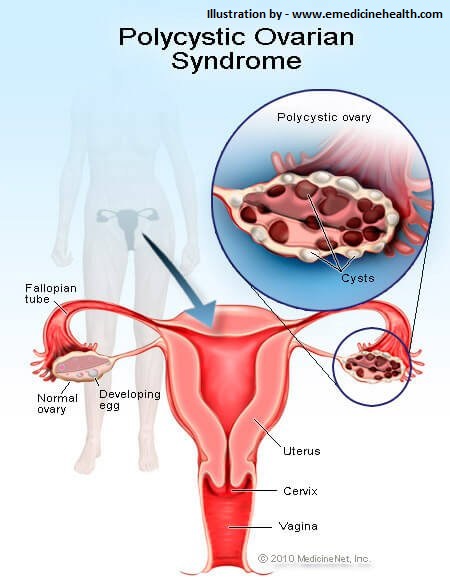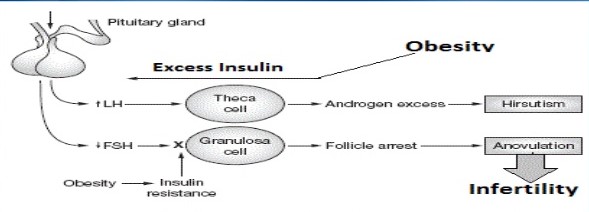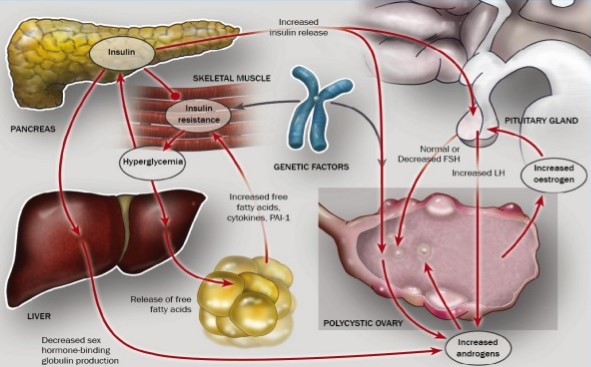Post By: Vishwanath Iyer Published on: December 16, 2016 Reading time: 6 minutes

PCOS – Impact
PCOS or Polycysytic ovarian syndrome is a condition where a woman’s level of sex hormones are out of balance resulting in formation of ovarian cysts. In fact, this condition got its name because of the finding of enlarged ovaries containing multiple small cysts (polycystic ovaries).
Polycystic ovarian syndrome (PCOS) is a relatively common hormonal disorder that affects between 2 and 8% women of reproductive age. Overall, approximately 18% women have PCOS, but over 70% are able to live normal lives. So, this means that having ovarial cysts does not necessarily mean that the person will suffer from PCOS.
The exact cause of PCOS – polycystic ovarian syndrome is not clear, though the signs and symptoms of women with PCOS have been documented. Also, it is possible that PCOS is inherited, though this is not proven.
However, it is known that the ovaries of women with PCOS may produce excessive amounts of male hormones, or androgens, and this can lead to disruptions in the menstrual cycle and impaired fertility.

Symptoms common to all women with PCOS are,
Women with PCOS are affected by the following parameters,
a- Stress: The reasons for PCOS are obscure. Generally speaking, there is some evidence of heredity contributing to its incidence. However, it is seen that there is greater incidence today than 50 years ago. Consequently, this can be taken as evidence that lifestyle and stress play a major role in the control of PCOS.
b- Weight: One of the side effects of PCOS is weight gain. Specifically, this could lead to Type 2 diabetes and heart related ailments. So, this makes weight control important.
c- Diet: Diet control impacts weight and stress. Hence, controlling this illness will require strict control over diet. Here, the main restrictions would be:

Intra body relationships in PCOS
PCOS intervention and support may be divided into the following areas;
|
Āsana (click on the āsana to get a detailed process) |
Beginner | Intermediate | Final | |
| No | Time frame | 3 months | 3 months | thereafter |
| 1 | Padmāsana | 3 minutes | 3 minutes | 3 minutes |
| 2 | Bhujaṃgāsana | 2 | 2 | 2 |
| 3 | Dhanurāsana | 2 | 2 | 2 |
| 4 | Pavanamuktāsana | 2 | 3 | 3 |
| 5 | Arda-halāsana | 2 | 2 | 3 |
| 6 | Naukāsana | 10 counts | 20 counts | 20 counts |
| 7 | Utkatāsana | 10 counts | 20 counts | 20 counts |
| 8 | Sundara-viparītakaraṇi (important) | 5 minutes | 10 minutes | 15 minutes |
| 9 | Sarvāngāsana (very important) | 5 minutes | 5 minutes | 5 minutes |
| 10 | Matsyāsana (very important) | 10 counts | 10 counts | 10 counts |
| 11 | Śirasāsana (very important) | 5 minutes | 5 minutes | 5 minutes |
| 12 | Arda-matsyendrāsana (important) | 10 counts | 10 counts | 10 counts |
| 13 | Uḍḍīyana | 1 x 5 counts | 2 x 5 counts | 2 x 10 counts |
| 14 | Nāḍī-śuddhi prāṇāyāma (important) | 5 x 2 cycles | 5 x 2 cycles | 5 x 2 cycles |
| 15 | kapālabhātī (very important) | 20 x 1 cycles | 30 x 2 cycles | 50 x 2 cycles |
| 16 | Śavāsana | 5 minutes | 5 minutes | 5 minutes |
| 17 | Meditation – dhyāna (sit in silence and focus on the breath – very important) | 10 minutes | 15 minutes | 20 minutes |
Okay thanks
Very nice